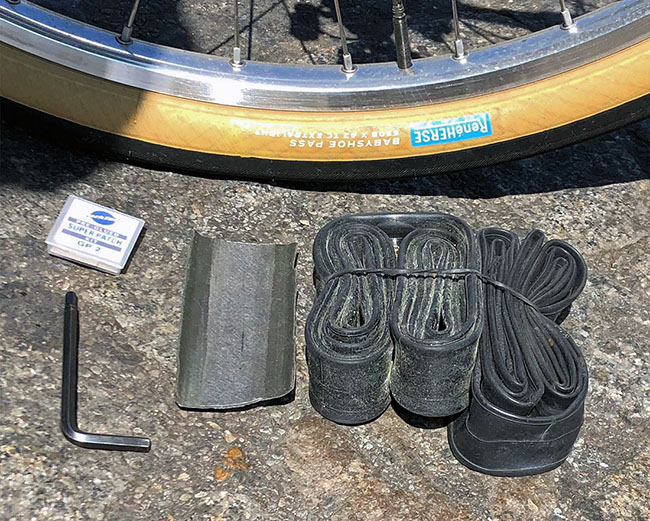Tool Kit for Paris-Brest-Paris

Before I started the 750-mile (1200 km) Paris-Brest-Paris on a brand-new bike, I thought about the tools I needed to bring. After months of training and the expense of traveling to France, it would be a shame not to finish the ride because of a mechanical.
I love the feel of a lightweight bike. My new Rene Herse weighs just 10.3 kg (22.7 lb.) fully equipped with fenders, lights, racks and even the pump. I didn’t want to carry unnecessary weight. But I also know that a few grams wouldn’t make a significant difference in my PBP time, and not being able to fix a problem could end my ride.
How to decide which tools to bring? I realized that bike-related mishaps fall into three categories:
1. Avoidable Problems
Most problems can be avoided through careful design and good workmanship. Rather than fix problems, I prefer to make sure that they won’t happen in the first place. This is especially important for issues that will stop my ride because they are impossible to fix on the road – things like broken frames and failures of major components.
The components of my new bike use quality materials, good design and careful workmanship. Most have been tested thoroughly, both in the lab and during 100,000s of miles on the road. Even the prototype rear derailleur has covered thousands of miles during 1.5 years of testing. I was confident that all the parts of my bike were unlikely to fail.
Bolts coming loose also fall into this category. The attachments for fenders, rack and other parts on my new bike are based on decades of experience. Bolts are dimensioned correctly and made out of appropriate materials: Steel where strength is paramount; titanium where bolts are large because they need to hold big parts (like brake pad posts and water bottle cages); aluminum in one rare instance where the bolts just hold the rear bake arms in place. All these bolts are unlikely to cause trouble.
Careful assembly is equally important. I used beeswax on most screws, which first lubricates the threads – important to get the tightening torque right – and then hardens to act as a thread-locking compound. (Crank bolts are lubricated with grease due to their high torque and large size.) There is no Loctite anywhere on the bike, because it’s not needed with good design.
2. Wear and Tear
Most parts will fail eventually. For a ride as important as Paris-Brest-Paris, it makes sense to replace those that are easy to replace: tires, tubes and cables. With a new bike, these were not going to be an issue. Otherwise, I’d have replaced them before heading to France. On a bike that has seen a lot of use, I’d also check rims (or brake rotors) for wear, as well as brake pads.
Spokes on well-built wheels last 10,000s of miles – longer with wide tires, since they cushion the loads that reach the wheels – but eventually, they will fatigue and break. It was nice to have a fresh set of wheels for the ride. Otherwise, I would have carried a spare spoke and nipple, plus a spoke wrench.
3. Inevitables
Some problems are difficult to eliminate, but easy to fix. These are the only problems that I was prepared to fix on the road.
Flat tires fall into this category. They are not likely on the clean backroads of France: In six PBP, I’ve had just two flat tires. Both occurred during the same rainy 2007 ride, when I used part-worn tires in an attempt to gain speed, before we developed the Extralight casings. Still, no matter how few flats we get – whether it’s a flat every 3,600 km on my Rene Herse Extralights or every 10,000 km on ultra-tough, puncture-resistant tires, we need to be prepared for a flat tire.
I carried two spare tubes, not because that is the most flats I ever got in a single PBP, but because there is always a possibility of double pinch flats: Most roads in PBP are smooth, but there can always be construction sites, small curbs… I also carried a piece of tire casing as a tire boot. At night, I might run over something big and sharp that could cut my tire. I haven’t cut a tire in more than a decade, but I know it can happen. (An energy bar wrapper works as a tire boot in a pinch, but a dollar bill doesn’t.) My bike carries a pump on the seatstay, so I didn’t need to include one in my toolkit.
There was one other concern: On my new bike, the saddle height might need fine-tuning. For that, I would need a 5 mm wrench. And since I have a 4/5 mm combined wrench, I brought it. That way, I could adjust a fender stay if it got bent in a fall.
On bikes with narrow chains and integrated shift levers, chains can break. If my bike had that type of drivetrain, I might bring a lightweight chain tool. On my ‘manual’ bikes, I feel the gears engage, and I’ve never broken a chain.

During the 56+ hours on the road, I didn’t need any of my tools. My trouble-free bike brought me peace of mind. I was free to concentrate on pedaling well. My control stops were focused on getting food and rest, rather than messing with my bike. It made for an uneventful PBP, and that was a good thing.
What tools do you bring on long rides?


